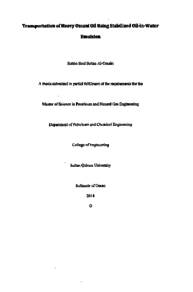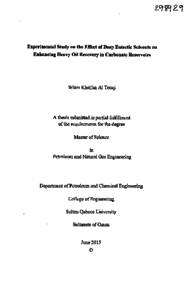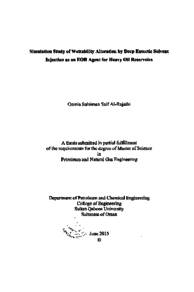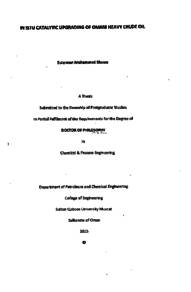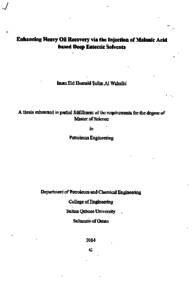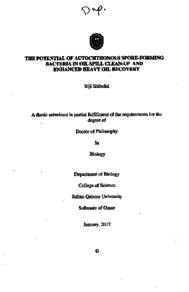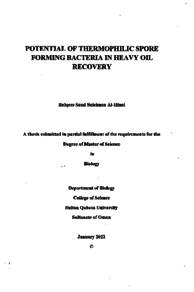Document
Transportation of heavy Omani oil using stabilized oil-in-water emulsion
Publisher
Sultan Qaboos University
Gregorian
2014
Language
English
Subject
English abstract
In this study, viscosity reduction of Omani heavy oil was investigated using stabilized oil-in water emulsions. Various factors that affect the stability and viscosity of the oil-in-water (O/W) and water-in-oil (W/O) emulsions were analysed. These parameters are oil content (40–80%), surfactant concentration (1, 3, and 5 wt%), salt concentration (0.2 and 2.0 wt %), and polymer concentration (10, and 100 ppm). The surfactant used in this study was Triton X 100, which is a non-ionic surfactant. The polymer used was high-molecular-weight anionic polyacrylamide. It is found that addition of surfactant stabilizes O/W emulsions with viscosity reduction of 100% below the phase inversion oil content. The optimum concentration to produce O/W emulsions without salt addition is found to be 3 wt% since it allows higher oil content before the viscosity sharply increases due to phase inversion. The addition of salts negatively affects the viscosity reduction only above the phase inversion oil content. However, it negatively affects stability of emulsions prepared using 40 and 50 % oil content. The most important result of this study is the use of minute amount of polymer (below 100 ppm) to induce very high viscosity reduction without the need for surfactant. This would have positive impact on the economics of the application. The stability of the polymer-stabilize O/W emulsions is lower than that using the surfactant. However, it can be enhanced by increasing the polymer dosage.
Description
Thesis
Member of
Resource URL
Arabic abstract
في هذه الدراسة، تم إستقصاء تخفيض لزوجة النفط العماني الثقيل باستخدام مستحلبات النفط في الماء المستقرة. وقد تم تحليل العوامل المختلفة التي تؤثر على الاستقرار والزوجة لكل من المستحلبات نفط في ماء (ن / م) وماء في نفط (م/ن). هذه المعايير هي محتوى النفط (40- ۸۰٪)، والتركيز السطحي (1، 3، و 5% بالوزن)، تركيز الملح ( ۰ . ۰۲ و ۲٪ بالوزن)، وتركيز البوليمر (۱۰ و ۱۰۰ جزء في المليون). خافض التوتر السطحي في هذه الدراسة هو تريتون 100-X ، ذو فعالية سطحية غير ايونية. البوليمر المستخدم عالي الوزن الجزيئي ويعتبر بولي اكراميد أنيوني. وجد أن إضافة خافض التوتر السطحي تادي إلى استقرار مستحلبات (ن / م) مع خفض اللزوجة ۱۰۰% عند مستوى محتوى النفط أقل من حالة الانعكاس. أيضا وجد أن التركيز الأمثل لإنتاج مستحلبات (ن/م) دون إضافة الملح هو ۳٪ بالوزن لأنه يسمح بوجود أعلى محتوى النفط قبل ازدياد اللزوجة المفاجيء بسبب حالة الإنعكاس. إضافة الأملاح يؤثر سلبا على خفض اللزوجة فقط فوق مستوى حالة إنعكاس محتوى النفط. ومع ذلك، فإن الملح يؤثر سلبا على استقرار المستحلبات المعدة باستخدام محتوی النفط 40 و 50٪. أهم نتيجة لهذه الدراسة هو استخدام كمية ضئيلة من مادة البوليمر (أقل من ۱۰۰ جزء في المليون) للحث على خفض الزوجة العالية جدا دون الحاجة لخافض التوتر السطحي. هذا من شأنه أن يكون له تأثير إيجابي على اقتصاديات التطبيق. إن قدرة البوليمر على استقرار مستحلبات (ن / م) أقل من استخدام خافض التوتر السطحي. ومع ذلك، يمكن تعزيز ذلك عن طريق زيادة جرعة البوليمر.
Category
Theses and Dissertations

